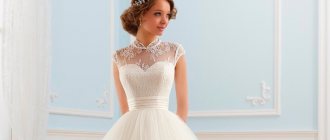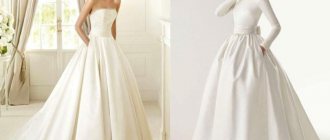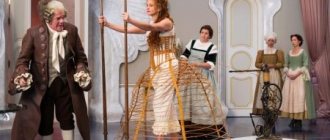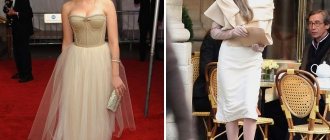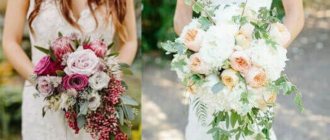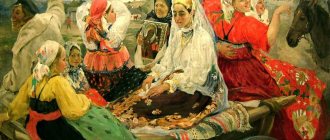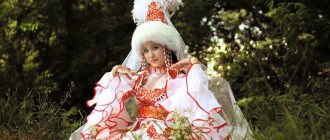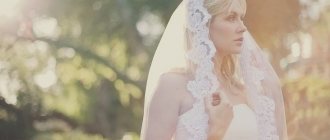In Ancient Rome, the bride's attire was very modest
To hide the girl’s beauty, she had to wrap herself in ordinary woolen blankets, but the groom was given a white outfit. During the Renaissance, wedding dresses in bright colors (red, bright yellow, orange) became popular. Wedding suits were decorated with lace and rich gold-colored embroidery. However, there were also more modest outfits in black, embroidered with silver thread.
In the 17th and 18th centuries, openwork lace, which was used to decorate skirts with numerous frills and bodices, became a mandatory attribute for decorating a wedding dress. Lush dresses with Medici collars and luxurious embroidery, lace trim or expensive fur were fashionable. The groom's wedding dress was decorated with a collar and cuffs made of lace. Different tones could be used (from delicate pastels to bright ones). The most popular colors were soft pink, light blue and green.
Girls from ordinary families walked down the aisle in gray dresses. Brown and beige outfits have become fashionable for going to church on Sundays.
Middle Ages
Medieval marriages, as a rule, were concluded for financial and political reasons, so the bride’s dress was an indicator of the well-being of her family and was made of velvet or brocade with draperies of valuable fur. Although the white color was considered a symbol of purity and innocence, it was considered impractical, so preference was given to bright shades, replacing white with blue or pink. The simple class tried, whenever possible, to copy the outfits of the highest nobility and sewed similar dresses from simple materials, usually in blue or green shades.
By the end of the 18th century, the Rococo style became fashionable
Newlyweds appreciated wedding dresses with a silver tint. The lush bottom was decorated with frills and ribbons, and also, for splendor, frames made of rods (willow, steel or plates made of whalebone) were used. To make the bride's waist look as thin as possible and her chest to become fuller, tight corsets were used. The bride's status was emphasized by a long train and sleeves.
In addition, at this time, the empire style became fashionable - straight-cut dresses with a high waist, which emphasized the sophistication and charm of the newlywed.
In the 19th century, wedding fashion changed very rapidly.
White color for wedding dresses came into fashion during the time of Queen Victoria of England. She was the first to shine at the wedding in a snow-white dress and veil, embroidered with luxurious golden lace. Subsequently, this style became known as “Victorian”. In those days, wedding dresses were simple and strict styles, no deep neckline, open shoulders or back. Even the newlywed's hands had to be covered with long sleeves and dressed in lace gloves. The bride's head was decorated with a long lace veil complete with an orange blossom wreath, symbolizing the girl's innocence and chastity. By the end of the century, wedding fashion had undergone some changes, as a result of which the skirts of wedding dresses became flowing and light, and the brides themselves resembled elegant porcelain figurines.
Wedding dress 1910
emphasized the sophistication and elegance of its owner. As a rule, these were loose-fitting dresses with lace sleeves, complemented by a veil and long gloves. Newlyweds of this time preferred closed outfits and a minimum of cosmetics. In 1920, shorter wedding dresses became fashionable than ten years later. Arm-baring and V-neck styles were especially popular.
Most often, brides used pearl threads as decoration. Wedding fashion corresponded to the clothing style characteristic of that time. Most brides preferred a white dress with a straight cut, low waist and high neckline. A veil of openwork lace completed the look. Brides of the 1930s favored glamorous A-line and fishnet styles made from shiny faux fabrics.
Brides of the gloomy 1940s, most often, were dressed in ordinary beautiful outfits, which they sewed themselves for the wedding. In 1945, dresses with long sleeves and gathered, voluminous shoulders became especially popular. The style is quite simple, but effective, emphasizing the thin waist. Pearls were most often used as decoration. The look was completed with light makeup on the upper part of the face and bright lipstick.
Modern fashion
Today, wedding fashion has become more flexible and practical. Modern manufacturers of wedding dresses are ready to offer a huge selection of products that can satisfy even the most extravagant tastes.
Wedding clothing remains relevant even in times of crisis. It’s not for nothing that many shows of famous brands always end with a model wearing a wedding dress. As in any other field, there are leaders here who define new style and trends, in other words, dictate fashion.
Many wedding dress manufacturers use the latest developments from famous fashion houses in their creations, creating high-quality products at an affordable price. Naturally, wedding chores are a very tiring, albeit responsible task. And this is where a wedding salon comes to the rescue.
A modern wedding dress is a space for flight of imagination and ingenuity.
As a rule, a good wedding salon provides a whole range of services, from accessories to individual tailoring of a wedding dress to satisfy the tastes of the most demanding and sophisticated customer.
Many salons purchase the latest wedding dresses wholesale from the manufacturer, thereby expanding the range of products provided. In addition, professional salons also provide a flexible system of discounts, which is also important. Wedding fashion in the twenty-first century has virtually no boundaries. Modern manufacturers of wedding dresses provide a huge selection of models, ranging from a traditional white dress to Gothic, Baroque or avant-garde. Each bride can decide for herself who she wants to be on this unforgettable day: an active young woman or a fragile princess, a dreamy hippie or an ancient goddess.
The real boom in wedding fashion occurred in the 50s of the 20th century.
when outfits with full skirts and necklines, complemented by a veil and short gloves, became popular.
Models that revealed shoulders and strapless dresses appeared, however, there were few brave brides who chose this style. Another 10 years later, short wedding dresses made of cotton, silk and taffeta became popular, and fashionistas replaced the traditional veil with a small hat with a veil or simply decorated their hair with flowers. Many brides chose wedding dresses with short sleeves complete with an airy veil. Designers of that time began to offer newlyweds styles decorated with ribbons, beautiful floral embroidery, lace, as well as luxurious models embroidered with pearls and beads. Bright lipstick has lost its relevance, replaced by matte pale colors and expressive eye makeup. In 1970, the traditional veil lost some of its popularity, but wide-brimmed hats came into fashion, which complemented wedding dresses made from flowing fabrics and, which became popular again, lace fabrics.
Wedding fashion of the 1980s was characterized by luxury and elegance. Brides are again choosing lush dresses, complemented by a long veil and tiara. The image of a beautiful bride of that period was perfectly presented by Princess Diana. The 1990s were characterized by dresses with tight-fitting silhouettes, ball gowns, complemented by a small wedding bouquet, and minimal makeup. In the next decade, brides continue to embrace slim and straight silhouettes, moving away from the classic veil. This accessory is replaced by flower crowns and tiaras. Stylish models with open shoulders are becoming the most popular. Shiny materials (for example, satin or silk) are coming into fashion, but lace is again, undeservedly forgotten.
Chinese wedding dresses
From ancient times to the present day in Asian countries, the main components of a bride's costume are silk and red. In China, the colors gold and red originally symbolize happiness and wealth. In Northern China, the bride wears a red, tight-fitting "cheung sam" dress with a high collar. In Southern China, brides wear the hung kwa costume, which consists of a jacket and several skirts layered on top of each other.
A Chinese bride's wedding dress can be decorated with embroidery, such as golden birds; in China they are a symbol of marriage, and embroidered flowers are a symbol of happiness and good luck.
The bride covers her face with a red silk veil, which can be replaced by beaded tassels, and decorates her head with a wedding tiara in the shape of a phoenix. According to the old tradition, during the ceremony and subsequent receptions, the bride changes her wedding dress three times.
Wedding dress Ballroom
A Ball Gown/Puffy Wedding Dress is a romantic style, an ideal choice for those brides who want to make a real fairytale wedding come true. The ballroom style of the wedding dress is characterized by a tight corset with a traditional full skirt, which can be one piece with the corset (one-piece) or separated, the cut of the dress is cut at the waist. The bodice is tight-fitting and fits the figure.
Two bodice options - real waistline or dropped waistline. From the waist, the dress is voluminous and very fluffy due to the folds and gathers that are formed by the overskirt, as well as the crinoline (petticoat) and underskirts that are required for a ballroom silhouette.
Wedding dress A-line and Princess
The A-line and Princess silhouettes are a classic style, usually one-piece, but sometimes separate, characterized by a tightly fitted corset with a regular or slightly high waist and gradually widening skirts. The two silhouettes A-line (the silhouette is shaped like the letter “A.”) and Princess are similar to each other. A distinctive feature is the width of the bottom of the skirt; the Princess style has a more flared skirt, and the material falls in large tails.
The Princess silhouette is created by raised seams that go from the shoulders or armholes through the chest line to the bottom along the entire dress, and the A-line silhouette is a narrow, figure-hugging top, and from the waist the dress smoothly expands to the bottom, the width of the skirt along the edge is as follows that the fabric lies flat without forming folds.
The neckline can be varied, as can the shape and length of the sleeves. Simply changing the neckline, adjusting the waist, or changing the fabric can highlight your best features and hide your flaws.
Delicate feminine silhouette - light flowing fabrics such as silk, chiffon, thin satin. For a clearer, more sculpted silhouette, use heavy fabrics that can support the shape, such as satin or taffeta.
Such wedding dresses fit well on almost all brides, because... The shape of wedding dresses is quite universal.
It will visually lengthen a petite figure, is suitable for tall and thin girls, and will add texture. Such dresses look great on pregnant brides, as they hide the belly.
Indian wedding dresses
In India, the traditional color for a wedding is red, so the bride usually wears a red gold-embroidered sari, which is an eight-meter fabric that envelops the entire body.
In some regions, the color of the wedding sari may be yellow, gold or white with a subtle design. The bride's head is adorned with a red veil and a gold thali is worn around her neck to symbolize her married life.
It is believed that the more gold the bride wears, the richer and happier her marriage will be, so the weight of jewelry can reach 8-10 kilograms.
